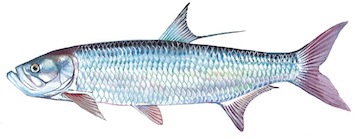At the start of the 20th century, a small village on the Texas coast didn’t have to brag about its good sport fishing. All people needed to hear was its name: Tarpon, after a feisty gamefish that could fight for hours.
 Tarpon are popular game fish on the Gulf and Atlantic coasts. Credit: South Carolina Department of Natural Resources
Tarpon are popular game fish on the Gulf and Atlantic coasts. Credit: South Carolina Department of Natural ResourcesTarpon are still one of the most popular gamefish on the Gulf and Atlantic coasts. They’re sought for their speed and stamina, and for the sight of their silvery flanks as they leap from the water. In fact, tarpon is also known as the “silver king” for its large silver scales.
In North America, tarpon are found from Virginia to Mexico. They winter in the warm waters of the Caribbean, then move toward Florida in spring. Some swim up the Atlantic coastline, while others spread out along the Gulf coast.
They usually stay in shallow coastal waters, including freshwater rivers. Using electronic trackers, though, a 2012 study found that some tarpon dive to depths of almost 500 feet.
Tarpon also have an ability that’s rare among fish: they can breathe air. Although they have gills, they have unusual air bladders that allow them to take in oxygen from the air. That allows them to survive in waters that are low in oxygen. But it also requires them to periodically return to the surface to take in air.
Incidentally, the name of that Texas town didn’t last. Since 1911 it’s been known as Port Aransas. The tarpon fishing didn’t last, either — the fish nearly vanished in the 1960s. But they’re slowly coming back — returning to the coastline near a town that once bore their name.
This episode of Science and the Sea was made possible by Texas Sea Grant.

